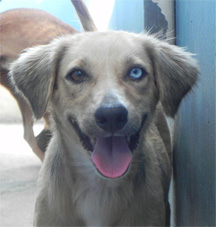This ailment has many other names which are used loosely to define the same condition. People, when describing ‘fits’, would use words like seizures or convulsions, epilepsy, paroxysms, apoplexy, etc.
Basically, in animals (I would not want to comment on the definition or symptomology in humans), a ‘fit’ or a seizure is a sudden and uncontrolled burst of activity which expresses itself as great excitability. It is usually not a frequent occurrence (unlike ‘epilepsy’ which is recurrent).
The animal foams at the mouth (increased salivation) and chews vigorously (champing/grinding of the teeth). The animal has a disoriented look and tends to walk/stagger aimlessly.

Some fits don’t follow the pattern described above. Instead, the dog will begin to bark incessantly while showing other signs of hysteria. Actually, some of them go temporary blind. The abnormal behaviour will be of such that the animal will become quite savage and turn on (bite/scratch) its owner.
The smart scientists have narrowed the cause of fits down to a sudden increase in the electrical activity within the brain. This activity, usually in one half (hemisphere) of the brain, could spread out involving other parts of the brain. That’s actually what is happening. But what precipitates this burst of electrical activity? A mechanical trauma – a clever way of saying a ‘blow on the head’ – seems often to be implicated in this malady. However, there are many cases where there might have been some other causal damage to the brain and where nerve cells died, creating scar tissue as the brain heals. This condition has been associated with the development of fits. Of course, any microbial agent (bacteria, viruses), which creates a brain infection and later inflammation (encephalitis), could also cause fits.

The literature has implicated poisons and tumours in the brain with fits. We have observed that a deficiency of calcium, for example, at suckling time, could result in an epileptic fit for the mother dog. It should be noted that there is some well founded suspicion that some breeds’ blood lines are especially prone to fits. This then suggests that there is a genetic predisposition for this ailment (congenital epilepsy).
There are some conditions which are not genuine seizures, but which have similar symptomology. For example, wasp (bee) stings can produce a shock situation which results in excited behaviour and eventually collapse (fainting and coma). Another example would be laryngospasm which results in a deficiency of oxygen entering the dog’s lungs.
The dog exhibits great anxiety as it attempts to inhale air. It will finally convulse and faint because of the lack of oxygen. This looks very much like a fit.
In fact, any situation that produces an anxiety attack (reaction to squibs, beatings, forced car rides, or placing the dog on a vet’s table, are pertinent examples) will show signs (hyperventilation, jerks, spasms, muscle twitching) like the start of a fit.
Next week, we will deal with epilepsy.
Please implement disease preventative measures (vaccinations, routine dewormings, monthly anti-heartworm medication, etc) and adopt-a-pet from the GSPCA’s Animal Clinic and Shelter at Robb Street and Orange Walk, if you have the wherewithal to care well for the animals. Do not stray your unwanted pets, take them to the GSPCA’s Clinic and Shelter instead. If you do not wish your pet to have puppies or kittens, you may exploit the GSPCA’s free spay and neutering programme. If you see anyone being cruel to an animal, or if you need any technical information, please get in touch with the Clinic and Shelter by calling 226-4237.




